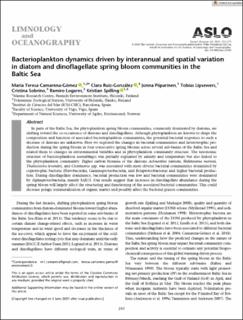| dc.contributor.author | Camarena-Gómez, María Teresa | |
| dc.contributor.author | Ruiz-González, Clara | |
| dc.contributor.author | Lipsewers, Tobias | |
| dc.contributor.author | Sobrino, Cristina | |
| dc.contributor.author | Logares, Ramiro | |
| dc.contributor.author | Spilling, Kristian | |
| dc.date.accessioned | 2022-02-22T13:00:01Z | |
| dc.date.available | 2022-02-22T13:00:01Z | |
| dc.date.created | 2021-06-16T17:06:11Z | |
| dc.date.issued | 2021 | |
| dc.identifier.citation | Camarena-Gómez, M. T., Ruiz-González, C., Piiparinen, J., Lipsewers, T., Sobrino, C., Logares, R. & Spilling, K. (2021). Bacterioplankton dynamics driven by interannual and spatial variation in diatom and dinoflagellate spring bloom communities in the Baltic Sea. Limnology and Oceanography, 66(1), 255-271. | en_US |
| dc.identifier.issn | 1939-5590 | |
| dc.identifier.uri | https://hdl.handle.net/11250/2980792 | |
| dc.description.abstract | In parts of the Baltic Sea, the phytoplankton spring bloom communities, commonly dominated by diatoms, are shifting toward the co-occurrence of diatoms and dinoflagellates. Although phytoplankton are known to shape the composition and function of associated bacterioplankton communities, the potential bacterial responses to such a decrease of diatoms are unknown. Here we explored the changes in bacterial communities and heterotrophic production during the spring bloom in four consecutive spring blooms across several sub-basins of the Baltic Sea and related them to changes in environmental variables and in phytoplankton community structure. The taxonomic structure of bacterioplankton assemblages was partially explained by salinity and temperature but also linked to the phytoplankton community. Higher carbon biomass of the diatoms Achnanthes taeniata, Skeletonema marinoi, Thalassiosira levanderi, and Chaetoceros spp. was associated with more diverse bacterial communities dominated by copiotrophic bacteria (Flavobacteriia, Gammaproteobacteria, and Betaproteobacteria) and higher bacterial production. During dinoflagellate dominance, bacterial production was low and bacterial communities were dominated by Alphaproteobacteria, mainly SAR11. Our results suggest that increases in dinoflagellate abundance during the spring bloom will largely affect the structuring and functioning of the associated bacterial communities. This could decrease pelagic remineralization of organic matter and possibly affect the bacterial grazers communities. | en_US |
| dc.language.iso | eng | en_US |
| dc.publisher | American Society of Limnology and Oceanography | en_US |
| dc.rights | Navngivelse 4.0 Internasjonal | * |
| dc.rights.uri | http://creativecommons.org/licenses/by/4.0/deed.no | * |
| dc.title | Bacterioplankton dynamics driven by interannual and spatial variation in diatom and dinoflagellate spring bloom communities in the Baltic Sea | en_US |
| dc.type | Journal article | en_US |
| dc.type | Peer reviewed | en_US |
| dc.description.version | publishedVersion | en_US |
| dc.rights.holder | © 2021 The Author(s) | en_US |
| dc.rights.holder | © American Society of Limnology and Oceanography | |
| dc.subject.nsi | VDP::Matematikk og Naturvitenskap: 400::Zoologiske og botaniske fag: 480::Marinbiologi: 497 | en_US |
| dc.source.pagenumber | 255-271 | en_US |
| dc.source.volume | 66 | en_US |
| dc.source.journal | Limnology and Oceanography | en_US |
| dc.source.issue | 1 | en_US |
| dc.identifier.doi | https://doi.org/10.1002/lno.11601 | |
| dc.identifier.cristin | 1916247 | |
| dc.description.localcode | Paid Open Access | |
| cristin.qualitycode | 1 | |

